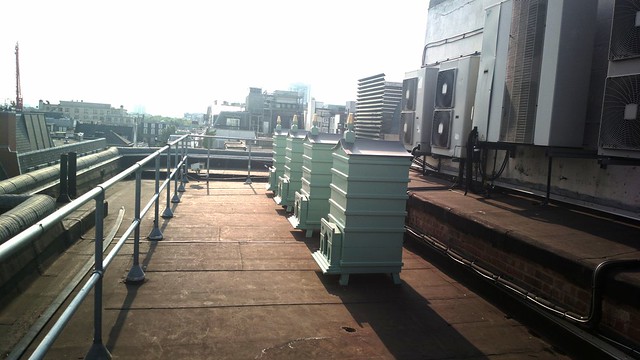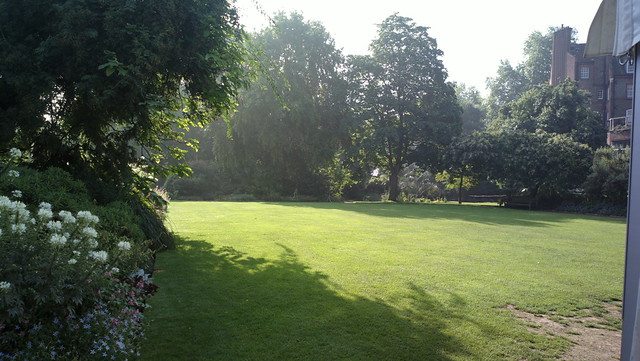
Beehives on some of the most expensive square footage in London at Fortnums in Piccadilly
There are more bees than people in London but they don’t seem to have such a housing problem as I found out during our day excursion to some of the capital’s apiaries.
Our Bee Day started off in the total bliss of the Chelsea Physic Garden, still one of my favourite places in all England. Their bees are special. Thanks to over 5,000 plants and trees (including the oldest pomegranate and olive trees in the land, etc, etc) they produce the most complex honey on offer winning four of the seven top category prizes at the annual honey competition in London. The odour of the flowers, of course, affects the taste of the honey. Tip of the day? If wasps and bees land on you, don’t swat them. They are looking for food and will go away.

A Paradise garden in the middle of Chelsea
Lunch was at another of my favourite hidden places, the Garden Museum Cafe, organiser of our trip (@GardenMuseumLDN) a deconsecrated church which shares a very high wall with Lambeth Palace. After a fascinating talk about all the flowers we should be planting to attract bees by author Maureen Little – ranging from dandelions in summer to ivy in Autumn – we ate a sumptious honey-themed vegetarian lunch – it included “honey pollen flowering salad” – on a table between the lovingly reproduced Elizabethan knot garden and the tomb of Captain Bligh, the anti-hero of Mutiny on the Bounty, who went on to be Governor of New South Wales, as Australia was then known. This is but one of the buried histories in which the Garden Museum abounds.
From there we were transported to what turned out to be the biggest surprise of the day, Fortnum and Mason’s world famous emporium which turned out to be far less stuffy than I thought it would be, not least because of its three architect-designed bee hives on the roof which provide honey which is sold in the store along with offerings from other growers. The shop, which has been in business since Mr Fortnum teamed up with Mr Mason in 1707 is now owned by the Garfield Weston Foundation which has almost 80% of the shares. Yes, Fortnums is a charity. This helps to expain why it is reaching out to small suppliers not just for honey (it is holding a competition for rooftop enthusiasts) but also for other products including scarves.
After watching hundreds of bees arriving at the rooftop hives, having flown by the most direct course (yes, – a bee line) from their feeding ground probably in St James Park we retired to a special room where we were invited to taste six distinctive kinds of honey. They included a “lime and chestnut blosom” from the roof, a lavender from France, two from Dorset (including hawthorn, willow, dandelion snd sycamore) and a lime blossom from Serbia washed down with a glass of bubbly.
These are only a few examples of the explosion of bee hives in the capital. Lots of other companies, institutions and individuals, including Tate Britain, the Museum of London and the Natural History Museum, are sporting hives creating fears that, unlike the rest of the country, London may have too many bees. For others, amid the turmoil of livingin the capital it is faintly reassuring that there will be honey still for tea.
Bee facts: 10 degrees C is the lowest temperature at which a bee can fly. It takes a million journeys from hive to flower to make a jar of honey. A hive typically has 60,000 worker bees, 2,000 drones and one Queen. ( source Chelsea Physic Garden) You can have new postings sent twice a month if you put your email address in the slot on the right of the screen.
